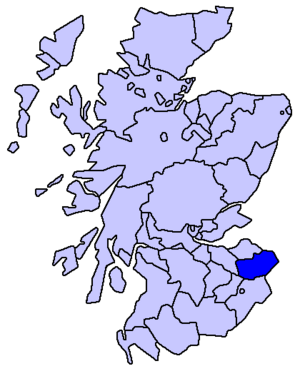Clan Blackadder facts for kids
Quick facts for kids Clan Blackadder |
|||
|---|---|---|---|
| Motto | Courage Helps Fortune | ||
| Profile | |||
| Region | Scottish Lowlands | ||
| District | Fife and Berwick-upon-Tweed | ||
 |
|||
| Clan Blackadder has no chief, and is an armigerous clan | |||
| Historic seat | Old Tulliallan Castle, Kincardine, Fife | ||
|
|||
Clan Blackadder is a historic Scottish clan. This family once owned lands close to the border between Scotland and England.
Contents
About Clan Blackadder Today
Today, Clan Blackadder does not have a leader, called a chief. This chief would be officially recognized by the Lord Lyon King of Arms. Because there is no recognized chief, the clan does not have a special standing under Scots Law.
Clan Blackadder is known as an armigerous clan. This means that at one time, the clan had a chief who held the official family arms. However, no one holds these arms today. The Blackadder family's coat of arms is described as: Blue, with three red roses on a silver chevron.
What's in the Name?
The name Blackadder comes from the lands of Blackadder in Berwickshire. These lands were named after the Blackadder Water. This is a river that flows through the Scottish Borders region. It is part of the River Tweed system.
The name Blackadder comes from an old English word, awedur. This word means "running water" or "stream." In 1426, a person named Blakadir de Eodem (meaning "of that Ilk," or "of the same place") owned these lands. Other early spellings of the name include Adam of Blacathathir in 1477. Robert Blackader was known in the 15th century, and Charles Blakater in 1486.
In 1942, a book about the Berwickshire way of speaking said the name was pronounced "ble-ke-TAR."
Important Blackadders (1450–1518)
The Fife Family Branch
A part of the Blackadder family moved to Tulliallan in Fife. This group included Robert Blackadder, who became a bishop. In 1492, he became the first Archbishop of Glasgow. He added a special crypt and aisle to Glasgow Cathedral. The archbishop passed away in 1508 while on a religious journey to the Holy Land. This Fife branch of the family supported Clan Douglas. In 1471, the archbishop also became the Abbot of Melrose, which was near the main Blackadder lands.
Later, Sir John Blackadder of Tulliallan was given the title of baronet in 1626. This title was not passed on after his death. However, the famous preacher John Blackadder (1622–1685) was legally the next in line. The preacher's son, Colonel John Blackadder, later became the governor of Stirling Castle.
The Main Family Branch
The Blackadders of that Ilk were known as Border Reivers. They were involved in many raids and disputes along the Anglo–Scottish border. This happened during the 15th and 16th centuries. Their home by the Blackadder Water was near Berwick-upon-Tweed. This town changed hands many times between England and Scotland.
The family received lands from James II of Scotland. This was a reward for their actions in stopping English raids. In 1518, the family lost their Border lands. This happened because the two young daughters who were heirs were married into the neighboring Clan Home (pronounced "Hume"). This event became known as "the fraud of the Homes."
According to a historian named William Anderson, these marriages happened like this:
Andrew Blackadder fought with Douglas at the Battle of Flodden in 1513. He was killed there, along with many other gentlemen. He left behind his wife and two young daughters, Beatrix and Margaret. The Homes of Wedderburn decided to try and take the Blackadder lands. They started by removing anyone close to the family who might cause trouble. They attacked Robert Blackadder, who was the Prior of Coldingham, and he lost his life. His brother, the Dean of Dunblane, also met the same fate. Others were also removed in a similar way.
Next, they attacked the Castle of Blackadder. This is where the mother and her two young daughters lived. The people guarding the castle refused to give up. But the Homes managed to take control of the castle. They took the mother and her children. They then arranged for the two daughters to be married to younger sons of the Home family, John and Robert, in 1518. The girls were only eight years old. They were kept at Blackadder Castle until they were old enough.

A Blackadder relative, Sir John Blackadder of Tulliallan, challenged this. He tried to get help from the Scottish Parliament. He also tried to use force to get back the Blackadder lands. In March 1531, he was executed for his involvement in a dispute with the Abbot of Culross. Sir John Blackadder was followed by his brother Patrick. Patrick also tried to get the lands back from the Homes. Anderson's story says that Patrick was attacked and killed by the Homes. This happened while he was trying to meet them to solve the disagreement.
By 1567, the dispute had become less intense. The Tulliallan Blackadders and the Homes of Wedderburn were allies of Mary, Queen of Scots. They were on the losing side in the important Battle of Carberry Hill. After this battle, Mary gave up her role as queen.
Later, the Blackadders gave up their claim to the Border lands. In 1671, Sir John Home was given the title of Baronet of Blackadder. Some Blackadder family members continued to farm their lands. They worked as tenants for the Homes. The last family burials at Edrom kirk happened in the 1980s.
William Francis Blackadder played for the Scottish rugby team in 1938. He received the DSO and OBE. He was an RAF ace during World War II.
Images for kids
See also
- Blackadder baronets
- Blackadder (disambiguation)
- Blackadder House
- Elizabeth Blackadder
- Rosemary Blackadder


